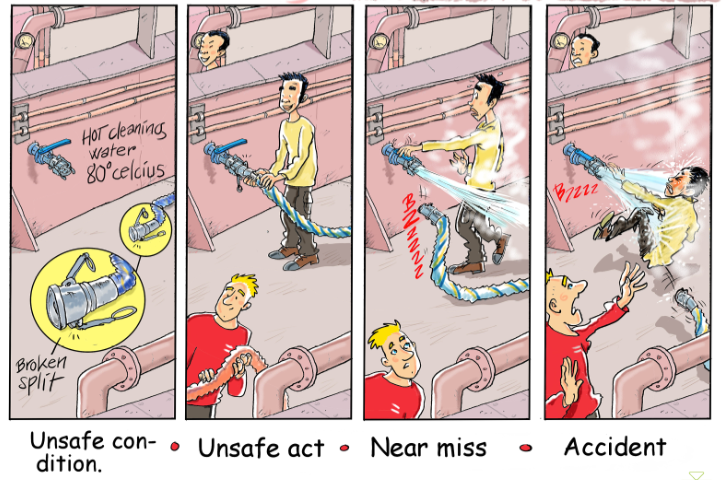Photo of the day: Tracking Near Miss Incidents
Does your organization have a process and program enabled to report on near misses easily? Are corrective actions being implemented to lower the frequency and severity of future occurrences? Are employees risk-sensitive?
A near miss is an unplanned event that did not result in injury or damage – but had the potential to do so. When only reporting claims and omitting near misses, your organization is not getting the full picture of potential hazards


It’s been discussed that with every claim there are upwards of 10 Near-miss incidents with the same root cause.
Organizations can use this data in a predictive fashion to uncover the potential of future occurrences and plan accordingly. Not only does this process make your organization a safer environment, but it also leads to a reduction in the cost of claims and insurance premiums.
Below are three areas your organization should focus on when reporting Near-miss incidents.
( Learn More: The-connection-between-near-misses-and-incidents . )
3 Important Factors When Tracking Near Miss Incidents
1. Create a supportive culture
A culture that encourages employees to report near misses will result in more being identified.
- Make sure the culture is supportive of being preventative towards near misses instead of potentially punishing employees for them. You do not want employees to fear coming forward with an issue that can pose a high risk to your organization, even if the employee is at fault.
- All employees must be risk-sensitive. They must be constantly informed about the value of risk management and risk management techniques.
- Employees have to be trained in the use, purpose, and application of all risk management policies and procedures. Emphasis must be given to the consequences of not adhering to policies.
2. Implement software
A comprehensive but easy-to-use software system should be implemented for tracking and managing all data.
- The system should allow for easy data submission through online forms accessible from all devices. Making the reporting process easier will increase timely submissions.
- Many employees within your organization will define near misses differently so provide multiple examples to act as a guide.
- Enable automated tasks and reporting. This ensures the causes are identified, and corrective actions are implemented and monitored to measure effectiveness.
3. Analyze the information
Regularly analyze data through predictive and trend analysis reporting.
- Near miss, trend reporting allows your organization to uncover high-risk areas that were previously unknown.
- Be predictive and proactive. Using this trend data, implement mitigation techniques to lower the frequency and severity of future occurrences.
- Ensure all areas of the organization are aware of the findings and the implemented corrective actions, policies, and procedures in place.
ClearRisk’s Claims, Incident, and Risk Management Software provide the exact benefits described above. Our automation and trend analysis will make it easy to identify and avoid near-misses. Want more information?
( Learn more:accident-incident-investigation-technique-guideline .)
Download the photo
More photos:
- Photo of the day: Identify the Hazards
- Photo of the day: Hand safety Facts
- Photo of the day: What are the hazards
- Photo of the day: Outline Safety observations
- Photo of the day: Safety Leader
- Photo of the day: Unsafe Conditions
- Photo of the day: Why is PPE important?
- Photo of the day: DO’S and DON’TS of Working At Heights
- Photo of the day: 5 Tips to keep your Crew Healthy and safe at work
- Photo of the day: Tracking Near Miss Incidents
- Photo of the day: 10 Elements of Successful Behavior-Based Safety Program
- Photo of the day:5-Signs your Near-Miss Reporting is failing
- Photo of the day:7 Ineffective Safety Practices (And What To Do Instead)
- Photo of the day:5 keys for effective Self-Management in lone worker safety
- Photo of the day: FrontLine supervisors are the LINCHPINS of safety
- Photo of the day: Fostering Engagement at the front line
- Photo of the day: workplace Hazards
- Photo of the day: What is the line of fire
- Photo of the day: How to Avoid the Fatal Four
- Photo of the day: Fire Safety checklist for workplace
- Photo of the day: Most common safety incidents in the workplace
- Photo of the day: Fire Emergency
- Photo of the day: Ladder Safety Tips
- Photo of the day: 8 Basic steps to wear a safety harness
- Photo of the day: You can prevent workplace Falls
- Photo of the day: Top10 Injuries in office work
- Photo of the day: Overhead powerline safety
- Photo of the day: Eyes on the Road The challenges of safe driving
- Photo of the day: 5 Ways to Reinforce Commuting With Positive Reinforcement
- Photo of the day: Safe Lifting at work
- Photo of the day: 5 Essential outcomes of an effective leadership survey process
- Photo of the day: Conveyors Safety Tips
- Photo of the day: Confined Space rescue
- Photo of the day: Construction Site fire Safety
- Photo of the day: Chemical Spill Emergency Response
- Photo of the day: Electric shock survival
- Breath Safely: The Proper Use of Respiratory Protection
- Photo of the day: Confined space safety Precautions
- Photo of the day: Choosing the Right Face Mask and the difference between a respirator and face mask
- Photo of the day: Importance of Mock drill and Fire Action Emergency Procedure
- H2S Gas and how to handle its Emergency
- Your steps to chemical safety
- Photo of the day: hierarchy of controls
- Photo of the day: Tips to reduce Heat stress in the workplace
- Photo of the day: Safety Equipment for Confined Spaces
- Photo of the day: Dangerous Goods Classes
- Photo of the day: Trenching Safety Tips That Can Save a Life
- Photo of the day: Mental health in the workplace
- Photo of the day: Emergency preparedness in the workplace
- Photo of the day: musculoskeletal disorders
- Photo of the day: Workplace Inspection
- Photo of the day: New worker Orientation & Safety Orientation checklist
- Photo of the day: Effective Health and Safety Committees
- Photo of the day: 10 Scaffold Safety Essentials
- Photo of the day: Incident Investigations
- Photo of the day: Preventing the spread of contagious illness
- Photo of the day: 5 ways to reduce the risk of Slipping and Tripping
- Photo of the day: Sitting at work
- How to use Plate Clamps Safely: Safety Moment#34
- Photo of the day: working in heat and Humidex Rating
- Photo of the day: Don’t be Driven to Distraction
- Photo of the day: Fatigue at Work
- Photo of the day: Noise in the affected workplace
- Photo of the day: Indoor Air Quality
- Photo of the day: WHMIS 2015 – Pictograms
- Photo of the day: Personal Protective Equipment last resort
- Photo of the day: Manual Material handling
- Photo of the day: Controlling COVID-19 in the Workplace-Physical Barriers
- Photo of the day: Generator Safety
- Photo of the day: Position for safety and comfort-Safety Tips
- Photo of the day: Cannabis and Impairment in the Workplace
- Photo of the day: sun safety in the workplace
- Photo of the day: Top FIVE Heavy Equipment Construction Site Safety Tips
- Photo of the day: Work-Related Asthma
- Photo of the day: choosing the right Anchorage
- Photo of the day: Protect your Head
- Photo of the day: Extension Cord Safety Tips
- Photo of the day: Concrete Truck Driver Hand Signals
- Photo of the day: Safe use of ladders and step ladders
- Photo of the day: Arc-Fault Circuit Interrupters (AFCI)
- Photo of the day: HSE Bulletin Board
- Photo of the day: Scissor Lift Safety
- Photo of the day: Managing Risks of Exposure to Solvents in the workplace
- Photo of the day: Flagman and Traffic control
- Photo of the day: Run Project safely with Crane Hand Signals
- Photo of the day: Read All Labels Work safe
- Photo of the day: Flood Safety Tips
- Photo of the day: Fall Protection Plans
- Photo of the day: Lockout and Tagout Safety
- Photo of the day: Types of Hand Protection
- Photo of the day: Types of Foot Protection
- Photo of the day: Floor Marking
- Photo of the day: Overhead Power lines Clearance




Effective corrective action for all capture Near-Misses will Impact positively on HSE Performance and consequently avoid Major incidents or Undesired events